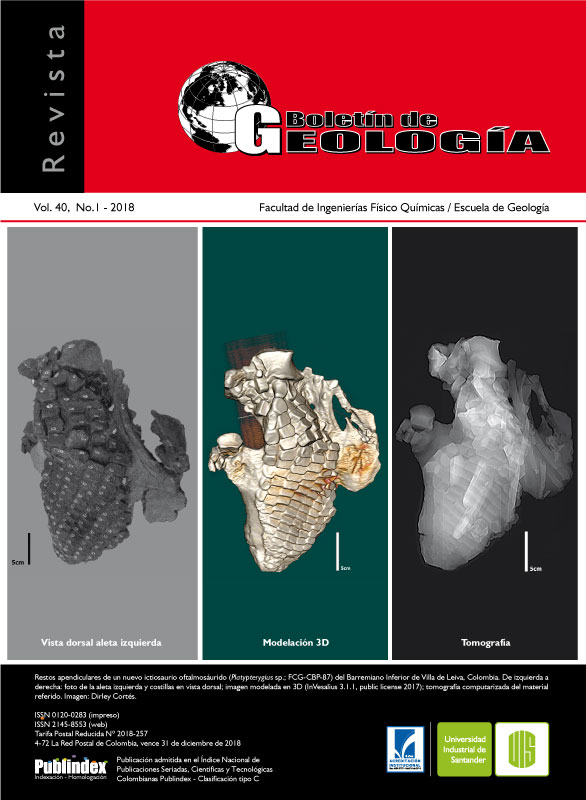Estudio geoquímico preliminar de aguas termales en el sistema volcánico Puracé (suroccidente colombiano): una aproximación para la exploración geotérmica
Publicado 2018-02-23
Palabras clave
- Volcán Puracé,
- Fuentes termales,
- Hidrogeoquímica,
- Geotermómetros,
- Sistema Alta Entalpia
Cómo citar
Altmetrics
Resumen
El Volcán Puracé está ubicado en el departamento de Cauca, al sur de Colombia en la cadena volcánica Coconucos. Este volcán es un interesante target para la exploración geotérmica, ya que es un volcán joven de tipo caldera, con actividad térmica (p.e. aguas termales y fumarolas). Usando análisis hidrogeoquímico de aguas termales, se determinó el tipo de agua, origen y relación con el sistema, temperatura del yacimiento, proceso de mezcla y finalmente las áreas potenciales para futuras exploraciones. Los tipos de agua analizados fueron: bicarbonatadas, cloruradas-diluidas, cloruradas - sulfatadas, acido sulfatadas y aguas sulfatadas con vapor de agua caliente. Los elementos conservadores, permitieron identificar la correlación entre los diferentes manantiales e inferir fuentes comunes. Los geotermómetros de solutos aplicados para cada grupo de agua termal definido, permitieron estimar la temperatura del yacimiento. Los resultados de geotermómetros de Sílice, se encuentran dentro de un rango de 120°C -170°C mientras que los geotermómetros de Cationes están por encima de estas temperaturas reflejando valores de 160°C a 220°C. Sin embargo, el geotermómetro de Cationes de baja temperatura identifica claramente otra zona de menor temperatura. Los procesos de mezcla y recarga fueron dilucidados a través de isótopos estables. Finalmente, el modelo geotérmico preliminar muestra dos zonas de sistema de alta entalpía (>150°C).
Descargas
Referencias
Arnórsson, S., and Gunnlaugsson, E. (1985). New gas geothermometers for geothermal exploration-calibration and application. Geochimica et Cosmochimica Acta, 49(6), 1307-1325. doi: 10.1016/0016-7037(85)90283-2.
Bohorquez, O.P., Monsalve, M.L., Velandia, F., Gil, F., y Mora, H. (2005). Marco tectónico de la cadena volcánica más septentrional de la cordillera central de Colombia: Boletín de Geología, 27(44), 55-79.
Burgos, M. (1999). Geochemical interpretation of thermal fluid discharge from wells and springs in Berlín geothermal field, El Salvador. Geothermal Training Programme, Report Number 7, Reykjavík, Iceland.
Chandrasekharam, D., and Bundschuh, J. (2008). Low-enthalpy geothermal resources for power generation. Leiden: CRC Press/Balkema.
Ellis, A.J., and Mahon, W.A.J. (1977). Chemistry and geothermal systems. New York: Academic Press INC.
Fournier, R.O. (1979). A revised equation for the Na/K geothermometer. Geothermal Resources Council Transactions, 5, 1-16.
Fournier, R.O. (1981). Application of water geochemistry to geothermal exploration and reservoir engineering. In L. Ryback, and L.J.P. Muffler (Eds.), Geothermal systems: Principles and case histories (pp. 109-143). Chichester: John Wiley and Sons.
Fournier, R.O., and Potter, R.W. (1982). A revised and expanded Silica (Quartz) geothermometer. Geothermal Resources Council Bulletin, 11(10), 3-12.
Fournier, R.O., and Truesdell, A. (1973). An empirical Na–K–Ca geothermometers for natural waters. Geochimica et Cosmochimica Acta, 37(5), 1255-1275. doi: 10.1016/0016-7037(73)90060-4.
Garzón, G., Salazar, S.P., Serna, D.Y., Bobadilla, L., Lesmes, L.E., Diago, J.C., and Mojica, J. (2004). Thermal springs of Colombia active volcanoes. 11th International Symposium on Water-Rock Interaction, Londres.
Giggenbach, W.F. (1988). Geothermal solute equilibria. Derivation of Na-K-Mg-Ca geoindicators. Geochimica et Cosmochimica Acta, 52(12), 2749-2765. doi: 10.1016/0016-7037(88)90143-3.
Giggenbach, W.F. (1991). Chemical techniques in geothermal exploration. In: F. D’Amore (Ed.), Applications of geochemistry in geothermal reservoir development (pp. 119-144). Roma: UNITAR.
Giggenbach, W.F. (1992). Isotopic shifts in waters from geothermal and volcanic systems along convergent plate boundaries and their origin. Earth and Planetary Science Letters, 113(4), 495-510. doi: 10.1016/0012-821X(92)90127-H.
Giggenbach, W.F. (1993). Redox control of gas compositions in Phillippine volcanic hydrothermal systems. Geothermics, 22(5-6), 575-587. doi: 10.1016/0375-6505(93)90037-N.
Giggenbach, W.F., and Goguel, R.L. (1989). Collection and analysis of geothermal and volcanic water and gas discharges. 4th Ed. Report No. CD 2401. Pentone: Department of Scientific and Industrial Research.
Karingithi, C.W. (2009). Chemical geothermometers for geothermal exploration. Short Course IV on Exploration for Geothermal Resources, organized by UNU-GTP, KenGen and GDC, at Lake Naivasha, Kenya, 1-22.
Marquínez, G., Rodríguez, Y., Terraza, R., y Martínez M. (2003). Geología de la plancha 365 Coconucos, escala 1:100.000. INGEOMINAS.
Maya, M. y González, H. (1995). Unidades litodémicas en la Cordillera Central de Colombia. Boletín geológico INGEOMINAS, 35, 43-53.
Monsalve, M.L. (2000). Catálogo de las volcanitas Neógenas de Colombia, Fascículo Formación Coconucos. INGEOMINAS, 32 p.
Nicholson, K. (1993). Geothermal fluids: Chemistry and exploration techniques. Berlin: Springer.
Nuti, S. (1991). Isotopic techniques in geothermal studies. In: F. D’Amore (Ed.) Applications of geochemistry in geothermal reservoir development (pp. 215-250). Rome, Italy: UNITAR/UNDP Centre on Small Energy Resources.
O’Brien, J. (2010). Hydrogeochemical characterization of the Ngatamariki geothermal field and a comparison with the Orakei Korako thermal area, Taupo Volcanic Zone, New Zealand. M.Sc. Thesis. University of Canterbury. New Zealand.
Powell, T., and Cumming, W. (2010). Spreadsheets for geothermal water and gas geochemistry. Proceedings of 35th Workshop on Geothermal Reservoir Engineering. Stanford University, California.
Servicio Geológico Colombiano. (2012). INVTERMALES. Inventario Nacional de Manifestaciones Hidrotermales. Consultado el 20 de febrero de 2017. http://hidrotermales.sgc.gov.co/.
Torres, M.P., Monsalve, M.L., Pulgarín, B., y Cepeda, H. (1999). Caldera de Paletará: Aproximación a la fuente de las ignimbritas del Cauca y Huila. Boletín Geológico de INGEOMINAS, 37, 1-15.
Tonani, F. (1980). Some remarks on the application of geochemical techniques in geothermal exploration. Proceedings, Advances in European Geothermal Research, 2nd Symposium. Strasbourg, France.
Truesdell, A. (1976). Summery of section III: Geochemical techniques in exploration. Proceedings 2nd United Nations Symposium on the Development and Use of Geothermal Resources. San Francisco, USA.

